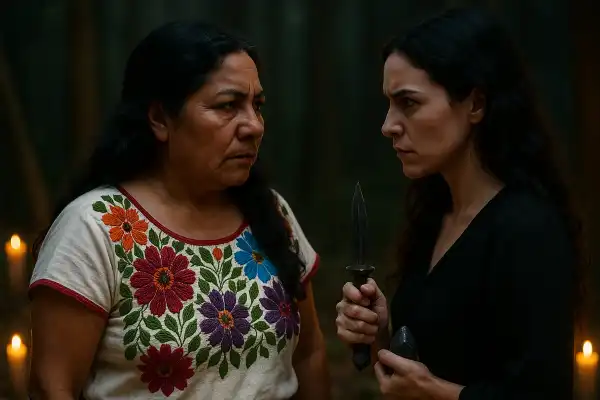Curanderismo vs brujeria represents one of the most misunderstood distinctions in Mexican healing traditions. Many people who encounter these ancient practices wonder about the differences between these two paths, often confused by conflicting information and cultural misconceptions. The question arises frequently among those seeking to understand indigenous Mexican spirituality and its place in modern healing.
María del Pilar Fernández, drawing from her deep roots in Oaxacan curandera lineage, recognizes the importance of clarifying these differences. Through her years of study and practice, she has witnessed how confusion between these traditions can prevent people from accessing the healing they need and honoring the sacred wisdom of their ancestors.
Curanderismo vs brujeria
Curanderismo is the art of folk healing focused on wellness, blessing, and spiritual cleansing, while brujería literally means “witchcraft” and encompasses broader magical practices that can include both healing and other forms of spiritual work. Though both traditions share historical roots and often use similar tools, their purposes, community perception, and spiritual approaches differ significantly.

The foundation of curanderismo
Curanderismo represents a holistic approach to wellness that has been practiced in the Americas for hundreds of years, blending Mexican indigenous culture with Catholic influences and traditional folk medicine. The word stems from “curar,” meaning “to cure,” reflecting its primary focus on healing body, mind, and spirit.
Curanderos and curanderas are considered healers par excellence, believed to possess a don de Dios (gift from God) to heal the sick. They specialize in treating conditions that Western medicine may not recognize, including:
- Susto (fright or soul loss)
- Mal de ojo (evil eye)
- Espanto (spiritual scare)
- Mal puesto (illnesses caused by witchcraft)
Curanderas often use healthy and appropriate humor during sessions along with prayer, spiritual cleansings, and healing ceremonies to restore balance and harmony to the body, mind, emotions, and spirit. Traditional healing methods include herbal remedies, limpias (spiritual cleansings), sobaderas (massage), and prayer work.
Understanding brujería in context
Brujería, meaning “witchcraft” in Spanish, is a syncretic Latin American tradition that combines Indigenous religious and magical practices with Catholic and sometimes African influences. The practice views all magical work as a form of healing for the client, examining spiritual conditions and wondering if there are physical or mental causes.
Brujería resembles practical, earthier types of magic focused on love, money, protection, and other life concerns, and includes both “magia blanca” (white magic) for healing and good luck, and “magia negra” (black magic) for more complex spiritual work. What gives brujería its complicated reputation is its association with spirit summoning, necromancy, and working with forces that curanderismo typically does not engage.
Community perception and acceptance
The most significant difference lies in how communities view these practices. Curanderismo is a respected practice within Hispanic communities, while brujería is often feared and maligned due to the power brujas and brujos hold and misinformation spread by the Catholic church.
In Mexican culture, a brujo is someone to fear and revere while a bruja is someone traditionally viewed with suspicion, though modern practitioners are reclaiming these terms. The curandero’s chief adversary in the struggle between good and evil is Satan and those who have made secret pacts with him—the brujos or brujas.
Approach to healing and spirituality
A curandera views a physical condition and wonders if there is a spiritually-based cause such as a crossing or curse, while a bruja views a spiritual condition and wonders if there is a physical or mental cause such as toxicity or injury. This fundamental difference shapes their entire approach to diagnosis and treatment.
Curanderismo emphasizes herbal preparations for healing and cleansing largely centered around Catholic prayers and rituals, while brujería incorporates more diverse elements including roots, bones, and objects from nature. Both traditions work with plants and spiritual forces, but their methodologies and underlying philosophies differ.
Modern evolution and practice
Both traditions have seen resurgence in recent years as U.S. Latinos reclaim once-taboo practices to connect with their roots, exercise self-care, and build community. American Brujería has evolved to include folk magic brought by Mexican immigrants, incorporating lighting of novenas, calling upon saints, veneration of Our Lady of Guadalupe, and spiritual cleansing through limpias.
Understanding these distinctions helps honor both paths appropriately. Curanderismo offers community-accepted healing focused on wellness and spiritual balance, while brujería provides broader magical practice that includes healing but extends to other forms of spiritual work. Both carry ancestral wisdom worthy of respect and understanding.
Disclaimer
Please note that Maria is not a physician, psychologist, or nurse. These culture-specific spiritual healing services are not meant to replace medical or psychological diagnosis and treatment. It is recommended that you see a licensed physician or licensed health care professional for any physical or psychological ailment you may have.
Last month, María worked with Isabella, a young mother from Oaxaca who had moved to the United States five years earlier. Isabella came seeking help for persistent nightmares and a feeling of disconnection from her homeland. Through careful consultation, María recognized the symptoms of susto—a condition where trauma causes spiritual displacement.
Using traditional curandera methods, María performed a limpia with rue and sweet basil, followed by prayers to Santa Teresa and the burning of copal incense. She prepared a tea blend of hierba buena and manzanilla for Isabella to drink each evening while visualizing her roots in Oaxacan soil. After three sessions spanning two weeks, Isabella reported that her nightmares had ceased and she felt spiritually grounded once again. María also connected Isabella with a local community group of Oaxacan families, recognizing that healing often requires both spiritual and social support to be complete.
